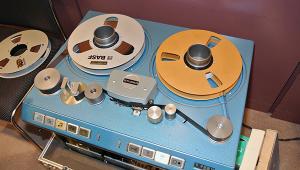Setting The Record Straight

How much longer can it last? In America, as here, vinyl sales have been growing year on year for nearly two decades. But a 2022 slowdown in growth set some commentators suggesting that the vinyl boom could soon be over.
That year's report by analytics firm Luminate showed that vinyl sales grew by just 4.2%. As Billboard summarised it: 'Forty-three percent of all albums sold in the US in 2022 were vinyl LPs, led by Taylor Swift's Midnights - but the format's growth curve is starting to level out'.
Billboard went on to detail the impact of Midnights, with a total sale for all its vinyl variants of 945,000 copies. Swift 'sold more vinyl LPs last year than the next two biggest sellers on vinyl combined: Harry Styles with 719,000 and The Beatles with 553,000'.
Swelling Sales
For 2023, US vinyl sales grew more strongly, up by over 14%. The pattern was similar in the UK, with vinyl unit sales only 2.9% up year-on-year in 2022, but 11% in 2023. Sales are now routinely swelled by multiple editions, with coloured vinyl and other variations. Dedicated Swift fans had to buy four editions of Midnights with different back covers, which when put together looked like a clock.
From one point of view, the vinyl record is a perverse and unwelcome throwback. Manufacturing more and more unnecessary plastic objects is hardly good for the planet.
'Vinyl records' revival threatens environment and health' was the headline of a 2021 news report by the American activist Environmental Working Group. EWG's article stated that vinyl record manufacture causes 12 times the greenhouse emissions of other physical music media, and deplored the general move to 180g vinyl: 'New-era vinyl emphasises 180g "audiophile" quality... thicker records mean more dirty PVC used in production and heavier loads for shipping. And 180g records don't sound any better - it's all a marketing conceit.'
Perhaps the EWG campaigners aren't old enough to remember the awfulness of the thinner records that were introduced in response to the oil crisis that occurred in 1973.
Happily, EWG could also point to the ways in which some forward-looking companies have set out to minimise the environmental damage - avoiding the old-fashioned steam-heat process and using entirely recycled vinyl, or a different plastic material. Look online today, and you can see Dutch pressing company Deepgroove claiming to be the greenest, while British loudspeaker manufacturer PMC has invested in Evolution Music's Evovinyl alternative [see p104].
All of which is a very far cry from the supposedly Good Old Days of vinyl production when, for example, hundreds of sweating workers at EMI's massive factory at Hayes in Middlesex churned out millions of black discs from long rows of crude hand-operated presses. EMI's huge main Hayes site, which housed its defence electronics production too, was eventually sold for development in 2011.
And although The Beatles still figure largely, the vinyl business of today is very different. Baby Boomers were brought up with vinyl while Gen Xers came into a world where CD had made vinyl obsolete. Millennials and Gen Zers have lived surrounded by every digital convenience, but find vinyl alluring, a collectable as much as a music source.
Easy Listening
These changes have not been lost on Heinz Lichtenneger, founder/owner of Pro-Ject, which launched a line of automatic turntables made in the Black Forest factory that produced the classic Dual auto decks of yore: 'Young people are not comfortable with an audiophile turntable, they just want to push a knob for convenience'. Pro-Ject even makes the T2 W, a deck with a Wi-Fi output.
Maybe Heinz could now offer an old-style multi-disc autochanger. Then you could listen to up to eight colourways of a Taylor Swift album in succession without moving from your seat. That is, if you wanted to actually play them at all.






















































